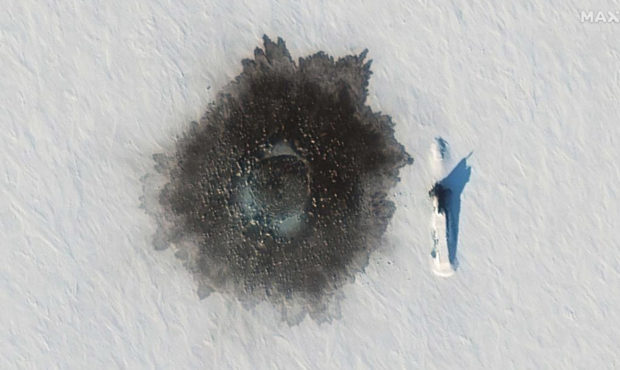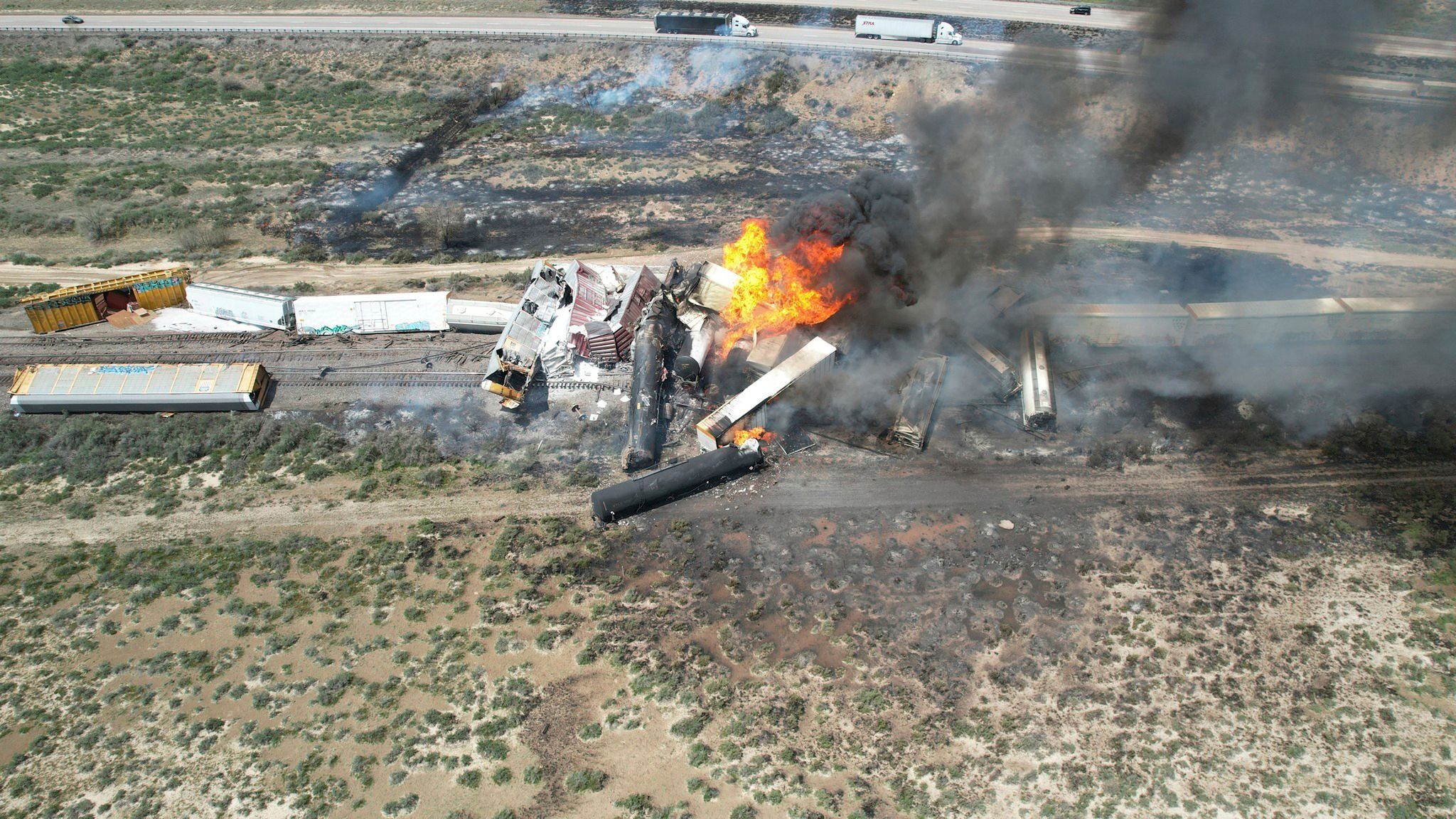Satellite images show huge Russian military buildup in the Arctic
Apr 5, 2021, 7:39 AM

Caption: A Russian Delta IV submarine photographed on top of ice near Alexandra Island on March 27, during an exercise, with a likely hole blown in the ice to its left from underwater demolition. Mandatory Credit: Satellite image ©2021 Maxar Technologies
(CNN) — Russia is amassing unprecedented military might in the Arctic and testing its newest weapons in a region freshly ice-free due to climate change, in a bid to secure its northern coast and open up a key shipping route from Asia to Europe.
Weapons experts and Western officials have expressed particular concern about one Russian ‘super-weapon,’ the Poseidon 2M39 torpedo. Development of the torpedo is moving fast with Russian President Vladimir Putin requesting an update on a “key stage” of the tests in February from his defense minister Sergei Shoigu, with further tests planned this year, according to multiple reports in state media.
This unmanned stealth torpedo is powered by a nuclear reactor and intended by Russian designers to sneak past coastal defenses — like those of the US — on the sea floor.
The device is intended to deliver a warhead of multiple megatons, according to Russian officials, causing radioactive waves that would render swathes of the target coastline uninhabitable for decades.
In November, Christopher A Ford, then assistant secretary of state for International Security and Non-Proliferation, said the Poseidon is designed to “inundate U.S. coastal cities with radioactive tsunamis.”
Experts agree that the weapon is “very real” and already coming to fruition. The head of Norwegian intelligence, Vice Admiral Nils Andreas Stensønes, told CNN that his agency has assessed the Poseidon as “part of the new type of nuclear deterrent weapons. And it is in a testing phase. But it’s a strategic system and it’s aimed at targets … and has an influence far beyond the region in which they test it currently.” Stensønes declined to give details on the torpedo’s testing progress so far.
Satellite images provided to CNN by space technology company Maxar detail a stark and continuous build-up of Russian military bases and hardware on the country’s Arctic coastline, together with underground storage facilities likely for the Poseidon and other new high-tech weapons. The Russian hardware in the High North area includes bombers and MiG31BM jets, and new radar systems close to the coast of Alaska.
The Russian build-up has been matched by NATO and US troop and equipment movements. American B-1 Lancer bombers stationed in Norway’s Ørland air base have recently completed missions in the eastern Barents Sea, for example. The US military’s stealth Seawolf submarine was acknowledged by US officials in August as being in the area.
A senior State Department official told CNN: “There’s clearly a military challenge from the Russians in the Arctic,” including their refitting of old Cold War bases and build-up of new facilities on the Kola Peninsula near the city of Murmansk. “That has implications for the United States and its allies, not least because it creates the capacity to project power up to the North Atlantic,” the official said.
The satellite images show the slow and methodical strengthening of airfields and “trefoil” bases — with a shamrock-like design, daubed in the red, white and blue of the Russian flag — at several locations along Russia’s Arctic coast over the past five years. The bases are inside Russian territory and part of a legitimate defense of its borders and coastline. US officials have voiced concern, however, that the forces might be used to establish de facto control over areas of the Arctic that are further afield, and soon to be ice-free.
“Russia is refurbishing Soviet-era airfields and radar installations, constructing new ports and search-and-rescue centers, and building up its fleet of nuclear- and conventionally-powered icebreakers,” Lt. Col. Thomas Campbell, a Pentagon spokesman, told CNN.
“It is also expanding its network of air and coastal defense missile systems, thus strengthening its anti-access and area-denial capabilities over key portions of the Arctic,” he added.
Campbell also noted the recent creation of a Quick Reaction Alert force at two Arctic airfields — Rogachevo and Anadyr — and the trial of one at Nagurskoye airfield last year. Satellite imagery from March 16 shows probable MiG31BMs at Nagurskoye for what is thought to be the first time, bringing a new capability of Russian stealth air power to the far north.
High-tech weapons are also being regularly tested in the Arctic area, according to Russian officials quoted in state media and Western officials.
Campbell added that in November, Russia claimed the successful test of the ‘Tsirkon’ anti-ship hypersonic cruise missile.
The Tsirkon and the Poseidon are part of a new generation of weapons pledged by Putin in 2018 as strategic game changers in a fast-changing world.
At the time US officials scorned the new weapons as technically far-fetched and improbable, yet they appear to be nearing fruition. The Norwegian intelligence chief Stensønes told CNN the Tsirkon as a “new technology, with hypersonic speeds, which makes it hard to defend against.”
On Thursday, Russian state news agency TASS cited a source in the military industrial complex as saying there had been another successful test of the Tsirkon from the Admiral Gorshkov warship, saying all four test rockets had hit their target, and that another more advanced level of tests would begin in May or June.
The climate emergency has removed many of Russia’s natural defenses to its north, such as walls of sheet ice, at an unanticipated rate. “The melt is moving faster than scientists predicted or thought possible several years ago,” said the senior State Department official. “It’s going to be a dramatic transformation in the decades ahead in terms of physical access.”
US officials also expressed concern at Moscow’s apparent bid to influence the “Northern Sea Route” — a shipping lane that runs from between Norway and Alaska, along Russia’s northern coast, across to the North Atlantic. The ‘NSR’ potentially halves the time it currently takes shipping containers to reach Europe from Asia via the Suez Canal.
Russia’s Rosatom state nuclear company released elaborately produced drone video this February of the ‘Christophe de Margerie’ tanker completing an eastern route across the Arctic in winter for the first time, accompanied by the ’50 Let Pobedy’ nuclear icebreaker for its journey in three of the six Arctic seas.
Campbell said Russia sought to exploit the NSR as a “major international shipping lane,” yet voiced concern at the rules Moscow was seeking to impose on vessels using the route. “Russian laws governing NSR transits exceed Russia’s authority under international law,” the Pentagon spokesman said.
“They require any vessel transiting the NSR through international waters to have a Russian pilot onboard to guide the vessel. Russia is also attempting to require foreign vessels to obtain permission before entering the NSR.”
The senior State Department official added: “The Russian assertions about the Northern Sea Route is most certainly an effort to lay down some rules of the road, get some de facto acquiescence on the part of the international community, and then claim this is the way things are supposed to work.”
Elizabeth Buchanan, lecturer of Strategic Studies at Deakin University, Australia, said that “basic geography affords Russia the NSR which is increasingly seeing thinner ice for more of the year making it commercially viable to use as a transport artery. This might yet transform global shipping, and with it the movements of 90+% of all goods globally.”
The State Department official believes the Russians are mostly interested in exporting hydrocarbons — essential to the country’s economy — along the route, but also in the resources being uncovered by the fast melt. The flexing of their military muscles in the north — key to Moscow’s nuclear defense strategy, and also mostly on Russian coastal territory — could be a bid to impose their writ on the wider area, the official said.
“When the Russians are testing weapons, jamming GPS signals, closing off airspace or sea space for exercises, or flying bombers over the Arctic along the airspace of allies and partners, they are always trying to send a message,” the official added.
Russia insists motives are peaceful and economic
Russia’s foreign ministry declined to comment, yet Moscow has long maintained its goals in the Arctic are economic and peaceful.
A March 2020 document by Kremlin policymakers presented Russia’s key goals in an area behind 20% of its exports and 10% of its GDP. The strategy focuses on ensuring Russia’s territorial integrity and regional peace. It also expresses the need to guarantee high living standards and economic growth in the region, as well as developing a resource base and the NSR as “a globally competitive national transport corridor.”
Putin regularly extols the importance of Russia’s technological superiority in the Arctic. In November, during the unveiling of a new icebreaker in St. Petersburg, the Russian President said: “It is well-known that we have a unique icebreaker fleet that holds a leading position in the development and study of Arctic territories. We must reaffirm this superiority constantly, every day.”
Putin said of a submarine exercise last week in which three submarines surfaced at the same time in the polar ice: “The Arctic expedition … has no analogues in the Soviet and the modern history of Russia.”
Among these new weapons is the Poseidon 2M39. The plans for this torpedo were initially revealed in an apparently purposeful brandishing of a document discussing its capabilities by a Russian general in 2015.
It was subsequently partially dismissed by analysts as a ‘paper tiger’ weapon, meant to terrify with its apocalyptic destructive powers that appear to slip around current treaty requirements, but not to be successfully deployed.
Yet a series of developments in the Arctic — including, according to Russian media reports, the testing of up to three Russian submarines designed to carry the stealth weapon, which has been suggested to be 20 meters long — have now led analysts to consider the project real and active.
Russia’s state news agency, RIA Novosti, cited a “source” on Monday saying that tests for the Belgorod submarine, especially developed to be armed with the Poseidon torpedo, would be completed in September.
Manash Pratim Boruah, a submarine expert at Jane’s Fighting Ships, said: “The reality of the weapon is clear. You can absolutely see development around the torpedo, which is happening. There is a very good probability that the Poseidon will be tested, and then there is a danger of it polluting a lot. Even without a warhead, but definitely with just a nuclear reactor inside.”
Boruah said some of the specifications for the torpedo leaked by the Russians were optimistic and doubted it could reach a speed of 100 knots (around 115 miles per hour) with a 100MW nuclear reactor. He added that at such a speed, it would probably be detected quite easily as it would create a large acoustic signature.
“Even if you tone it down from the speculation, it is still quite dangerous,” he said.
Boruah added that the construction of storage bays for the Poseidon, probably around Olenya Guba on the Kola Peninsula, were meant to be complete next year. He also expressed concerns about the Tsirkon hyper-sonic missile that Russia says it has tested twice already, which at speeds of 6 to 7 Mach would “definitely cause a lot of damage without a particularly having big warhead itself.”
Katarzyna Zysk, professor of international relations at the state-run Norwegian Institute for Defence Studies, said the Poseidon was “getting quite real,” given the level of infrastructure development and testing of submarines to carry the torpedo.
“It is absolutely a project that will be used to scare, as a negotiation card in the future, perhaps in arms control talks,” Zysk said. “But in order to do so, it has to be credible. This seems to be real.”
Stensønes also raised the concern that testing such nuclear weapons could have serious environmental consequences. “We are ecologically worried. This is not only a theoretical thing: in fact, we have seen serious accidents in the last few years,” he said, referring to the testing of the Burevestnik missile which was reported to have caused a fatal nuclear accident in 2019. “The potential of a nuclear contamination is absolutely there.”
This story has been updated to correct the spelling of Manash Pratim Boruah’s last name.
The-CNN-Wire
™ & © 2021 Cable News Network, Inc., a WarnerMedia Company. All rights reserved.













